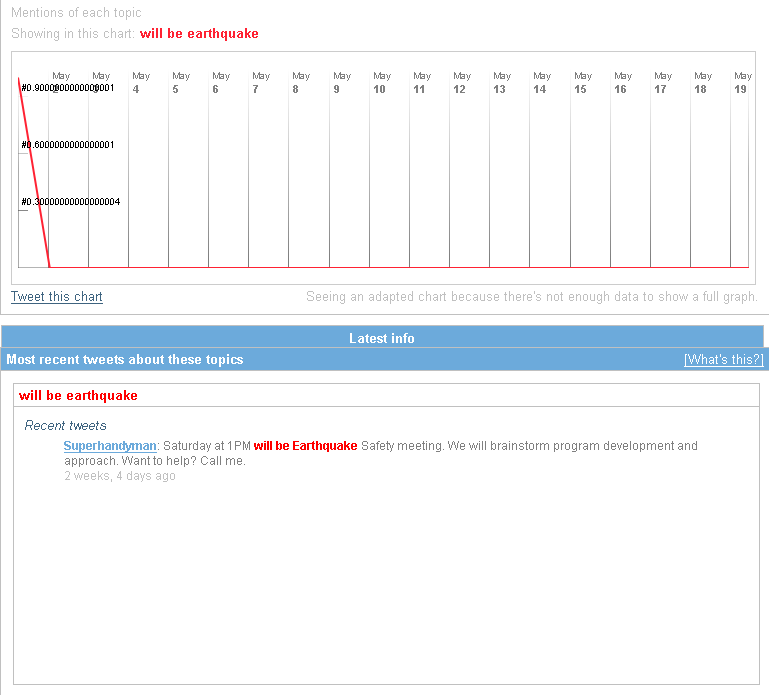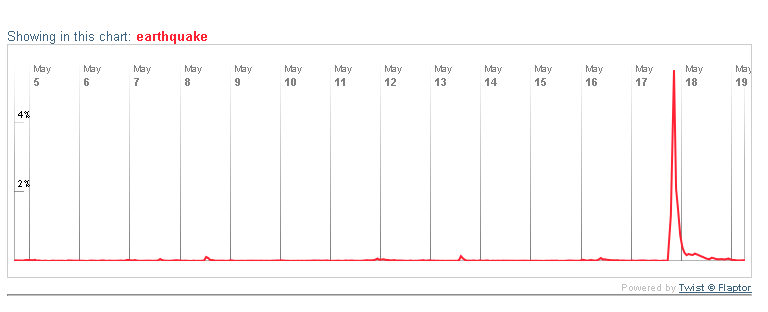
Below you see the past (NOT LIVE) record of twitter results in the 30 days leading up to the May 17th,2009 Los Angeles 4.5 earthquake.
Below is a graph of mentions of "Earthquake" in Twitter 30 days before the May 17th Los Angeles 4.5 earthquake. You can clearly see the spike in the mention of the word "earthquake" which occurs immediately AFTER the earthquake in Los Angeles on the 17th. On Sunday at 20:30 PM during that 20 minute sampling window Twist was measuring fully 5.5% of all tweets at that moment contained the word "earthquake".

Below is a graph of the number of tweets with some phrases that might indicate strange dog or cat behavior in Twitter 30 days before the May 17th Los Angeles 4.5 earthquake. There are no significant mentions of strange animal behavior before the quake although there are many AFTER the earthquake occurs which functions as a reasonable control data point for the search terms used
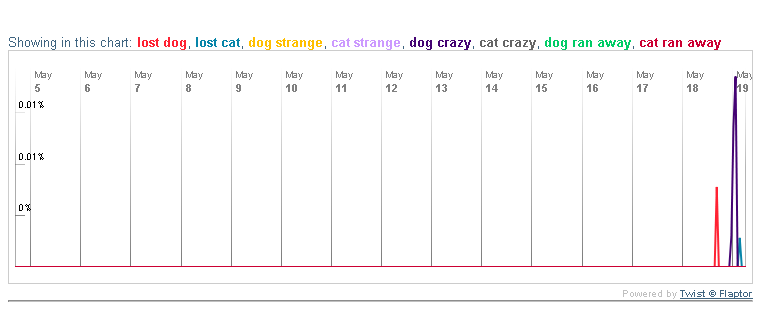
Below is a graph of mentions "cat" in Twitter 30 days before the May 17th Los
Angeles 4.5 earthquake. This provides a baseline during the period for the
number of tweets about cats in general. It also serves another purpose. It is a
broad search to see if there is an increase in owners noticing or Tweeting about
their animals for whatever reason before the quake. It is possible owners might
notice their animals more because of the animal's strange behavior yet owners
might tweet about other things regarding their animal and not mention the
strange behavior specifically. Thus this search may act as a more broad
indication of the increase in noticability of the pet by the owner before the
quake.
The numbers of tweets about "cat" does rise by a significant
percentage in the day prior to the earthquake. However the total number of
tweets on that day is peeking at Saturday at 4:30 PM at .36% of all tweets which
is significantly above the estimated baseline of .21% for the previous and
following periods. Unfortunately the total number of tweets being graphed by
"Twist"is unknown therefore it is impossible to determine a statistical
significance in the strictest sense. However other searches have produced exact
numbers of tweets on the vertical axis by Twist when tweets were as high as 50
therefore it is reasonable to conclude that the number of tweets on the day May
6 th proceeding the quake is higher than 50 total thus raising the confidence in
the significance of the increase. Furthermore a search of common terms to try to determine a correlation between percentages and actual numbers of Tweets resulted in one indication that a graph peak at .03% equalled 12 tweets at that time. Thus IF tweet traffic is relatively constant 1% of Twist measured tweet traffic may equal 4000 Tweets or messages from Twitter users. using an estimated total tweet traffic of 40,000 messages then .36% mentioning "cat" means 144 messages.
Of all phrase Tweets measured by this
study, this Tweet increase in the mention of "cat" is the most significant of
all phrase measurements given both the high percentage increase from the 30 day
baseline and the timing which occurred exactly one day before the earthquake
struck.
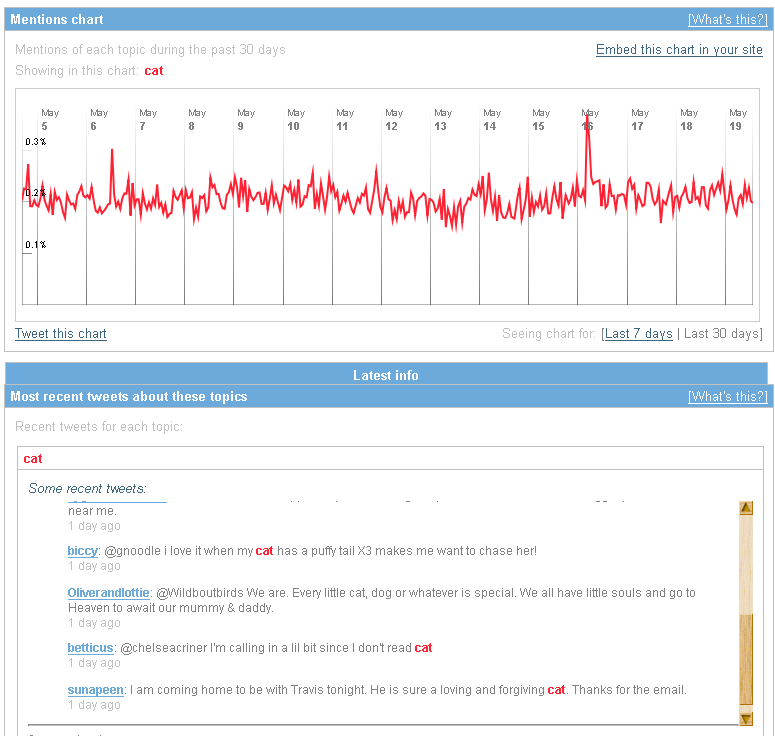
Below is a graph of mentions of "my cat" in Twitter 30 days before the May 17th Los Angeles 4.5 earthquake. A slight narrowing of the above methodology to attempt to limit tweets to owners of animals. There is another large jump in tweets more than doubling the apparent baseline number of tweets however this occurs four days prior to the quake for this phrase. Additionally the jump is only slightly higher than a jump which occurred almost a full 30 days before the quake indicating perhaps that such jumps are not uncommon. Perhaps significantly though the jump four days prior to the quake is higher than immediately following the quake when one might expect many pet owners would be Tweeting about the reaction of "my cat" to the earthquake.
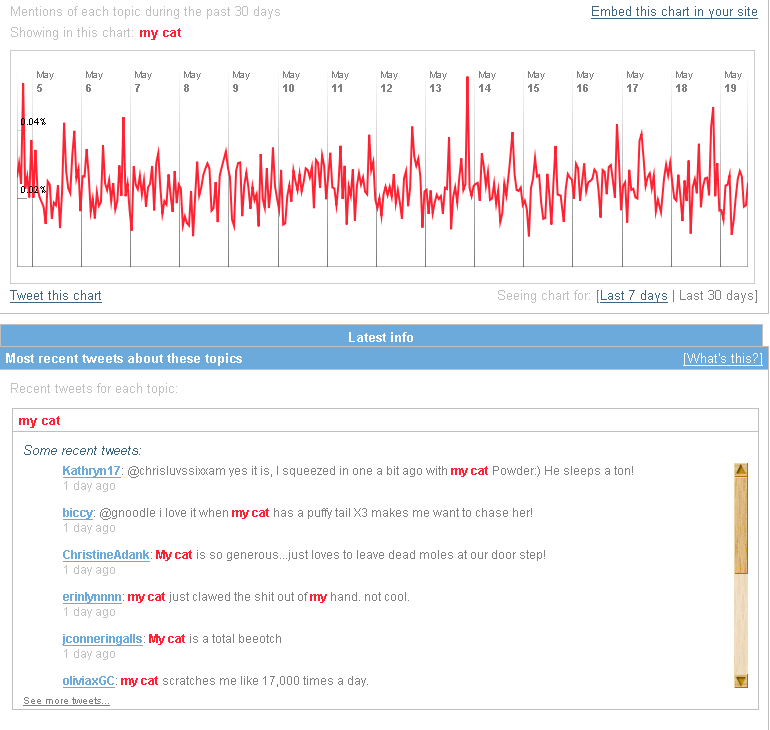
Below is a graph of mentions of "cat disappeared" in Twitter 30 days before the May 17th Los Angeles 4.5 earthquake. The jump in the tweets about "cat disappeared is large immediately after the earthquake (from a baseline of 1 to 6 tweets) however a closer examination of some of the actual tweets shows a problem in methodology of simple numerical comparison of the number of tweets. It's clear from reading some of the tweets that a news story broke from The Associated Press on May 18, 2009 MARION, Ark. (AP) about a specific cat named "Bubba" which was trapped in a wall and this story about a single incident of a cat disappearing was "retweeted" by many Twitterers thus artificially raising the presumption that more cats disappeared.
For similar reasons "dog" as a search term is ineffective. This is due to the fact that the term "Dog" has enter slang possibly due to the huge social impact of the show "American Idol" and the judge Randy Jackson who uses the term constantly. As a result Twitter users often use the term in a way that is completely unrelated to pet dogs and even sometimes include the term "dog" in their Twitter name. Twist is unable to distinguish between those using the term dog as part of their Twitter name or using the term in a way related or unrelated to the common pet. As a result a single Twitter with the term dog in his name can radically change the Tweet count for "Dog" even when they are not Tweeting about dogs at all.
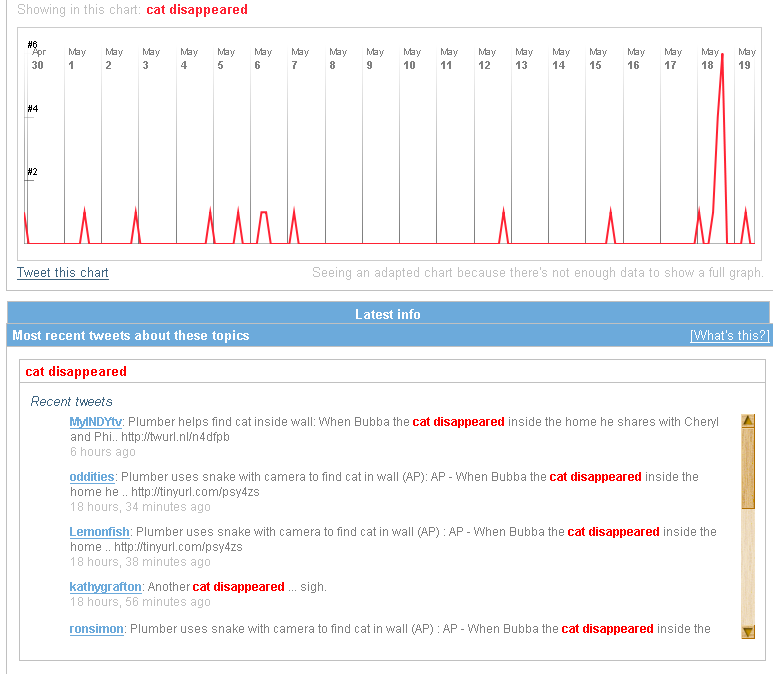
Below is a graph of mentions of "cat is acting strange" in Twitter 30 days before the May 17th Los Angeles 4.5 earthquake. There is exactly one tweet measured Thursday at 4:00 which is indicted by Twist as .09 tweets . Clearly such a specific search of Tweets shows that the number of tweets is too low at this time for specific analysis of very such specific phrases in Twitter.
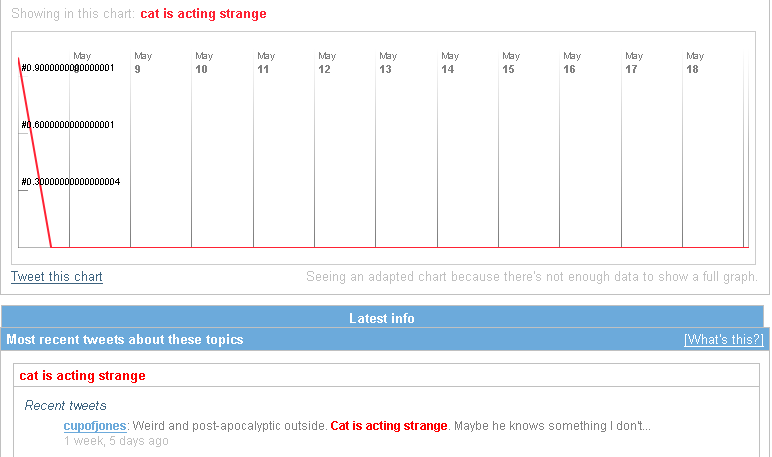
Below is a graph of mentions of "cat is acting weird" in Twitter 30 days before the May 17th Los Angeles 4.5 earthquake.
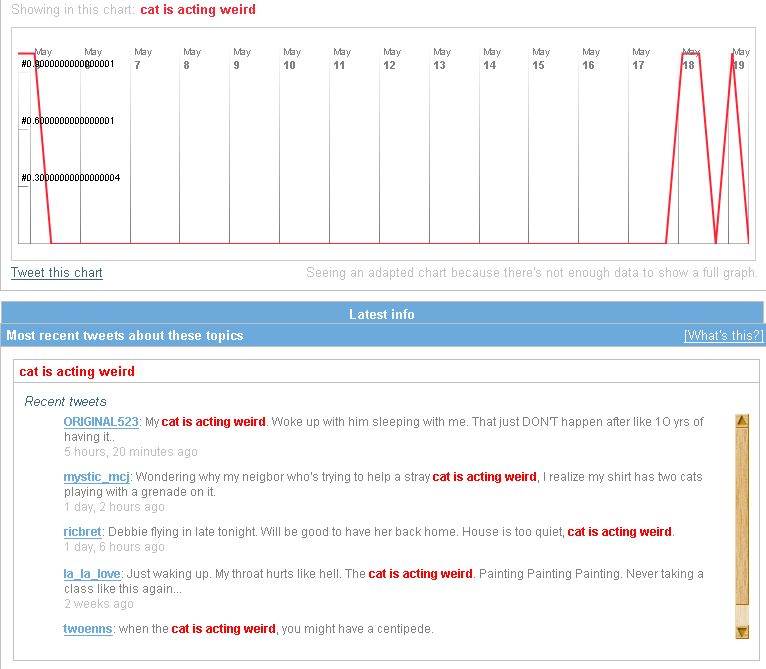
Below is a graph of mentions of "cat ran" in Twitter 30 days before the May 17th Los Angeles 4.5 earthquake. Theoretically such a phrase should capture tweets including "my cat ran away" and "my cat ran and hid" etc. however it could also capture tweets with no significance such as "a cat ran to its food bowl".
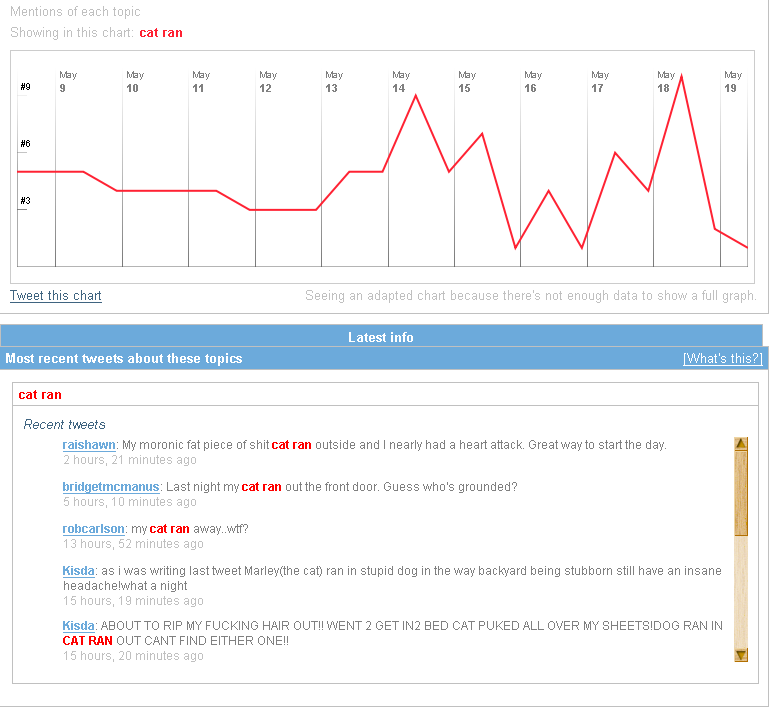
Below is a graph of mentions of "cat ran away" in Twitter 30 days before the May 17th Los Angeles 4.5 earthquake.
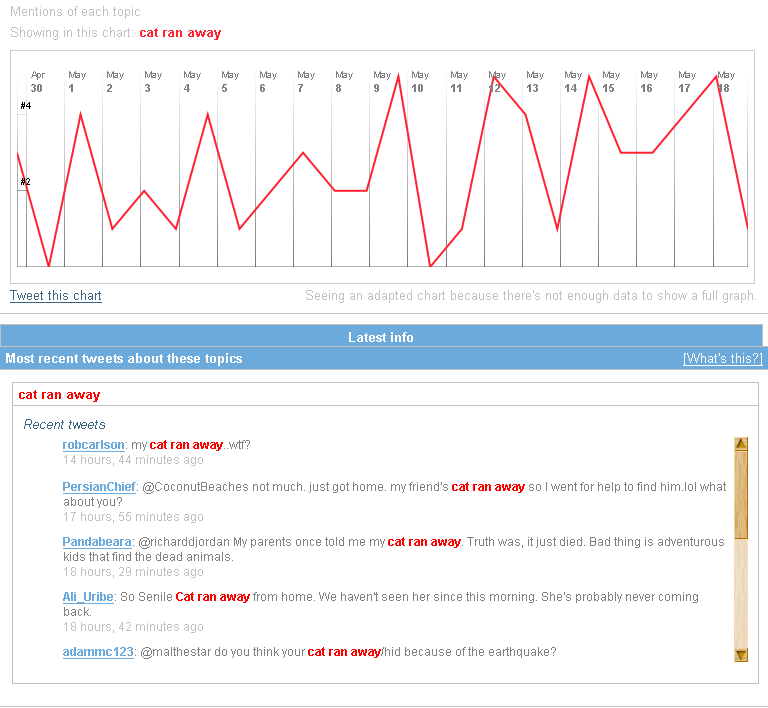
Below is a graph of mentions of "dog disappeared" in Twitter 30 days before the May 17th Los Angeles 4.5 earthquake.
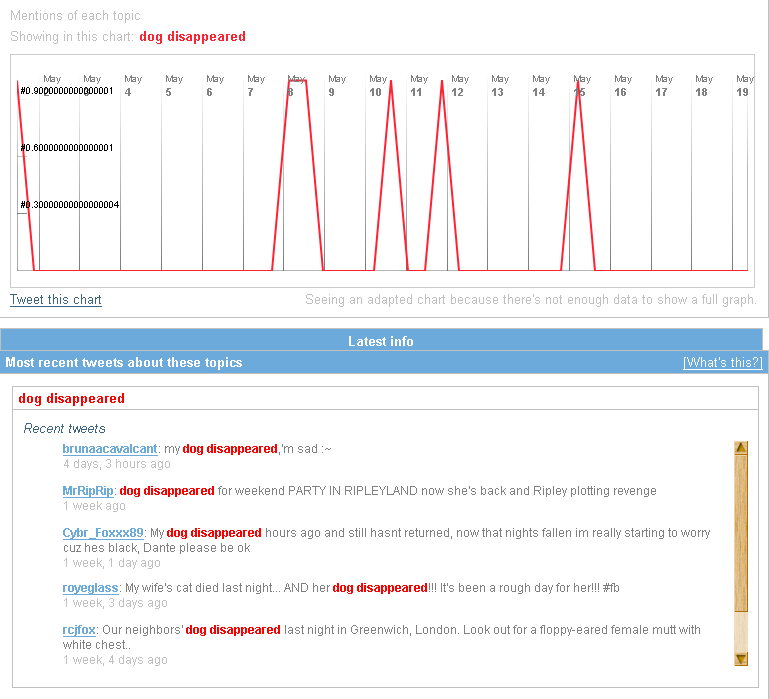
Below is a graph of mentions of "dog howling" in Twitter 30 days before the May 17th Los Angeles 4.5 earthquake.
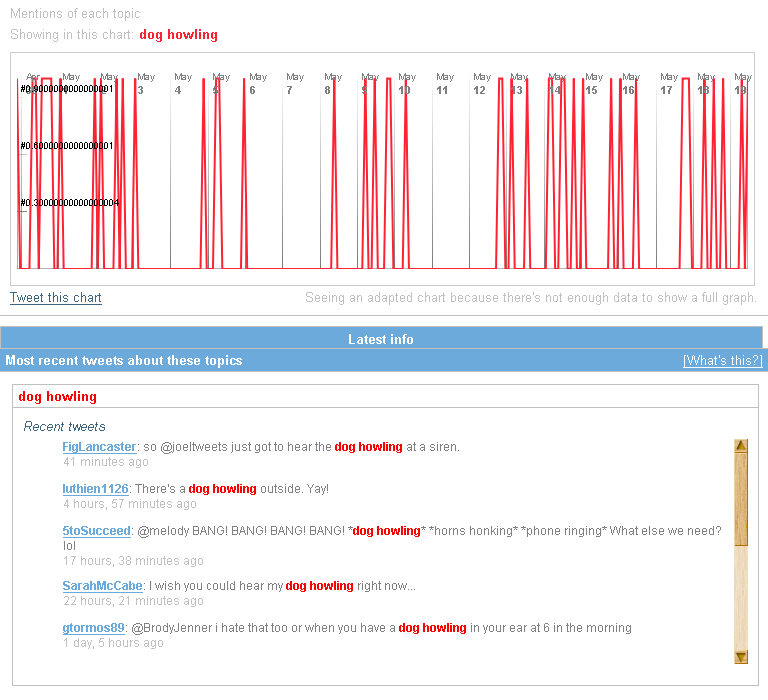
Below is a graph of mentions of "dog ran" in Twitter 30 days before the May 17th Los Angeles 4.5 earthquake.
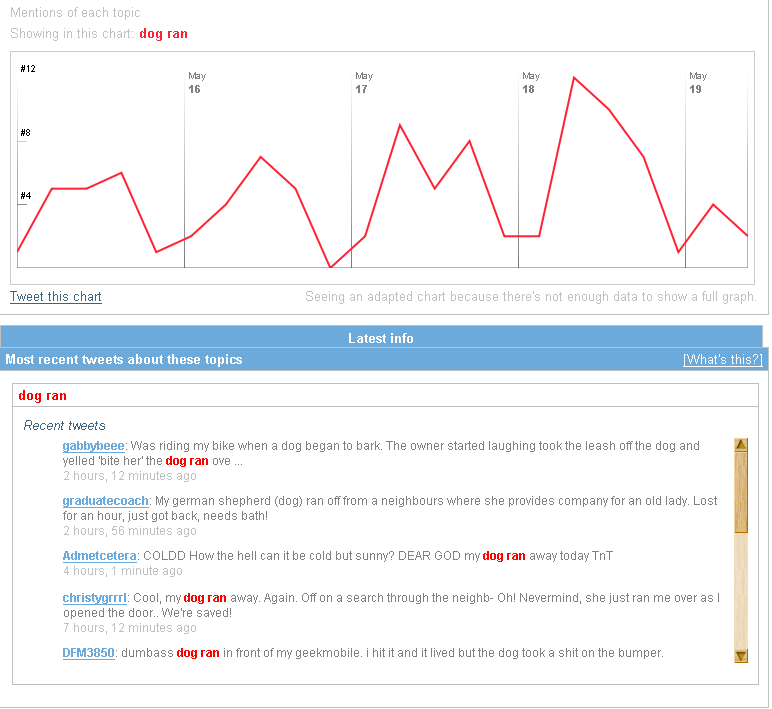
Below is a graph of mentions of "dog ran away" in Twitter 30 days before the May 17th Los Angeles 4.5 earthquake. This is a more specific phrase search than above which means the prior search can be seen as a control of sorts.
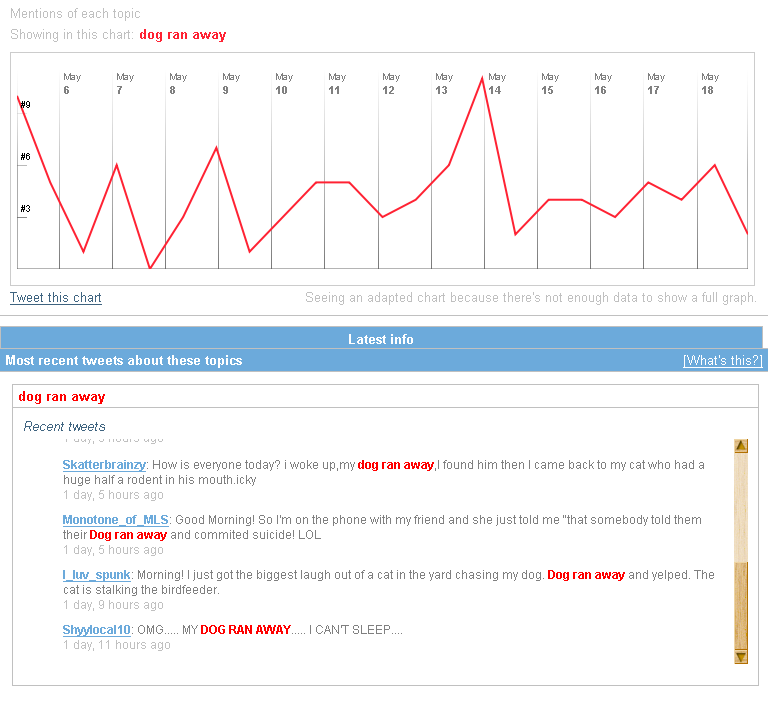
Below is a graph of mentions of "I found my cat" in Twitter 30 days before the May 17th Los Angeles 4.5 earthquake. If one presumes that animals may leave home before an earthquake in fear then perhaps owners might be more inclined to tweet about finding their animal if it returns once the earthquake is over. (significant note - as of the publication time of this study the aftershock sequence is still very active including a major 4.1 aftershock which has occurred literally today May 19, 2009 . Thus perhaps not enough time has elapsed for animals which ran away to have returned "when the danger has passed.")
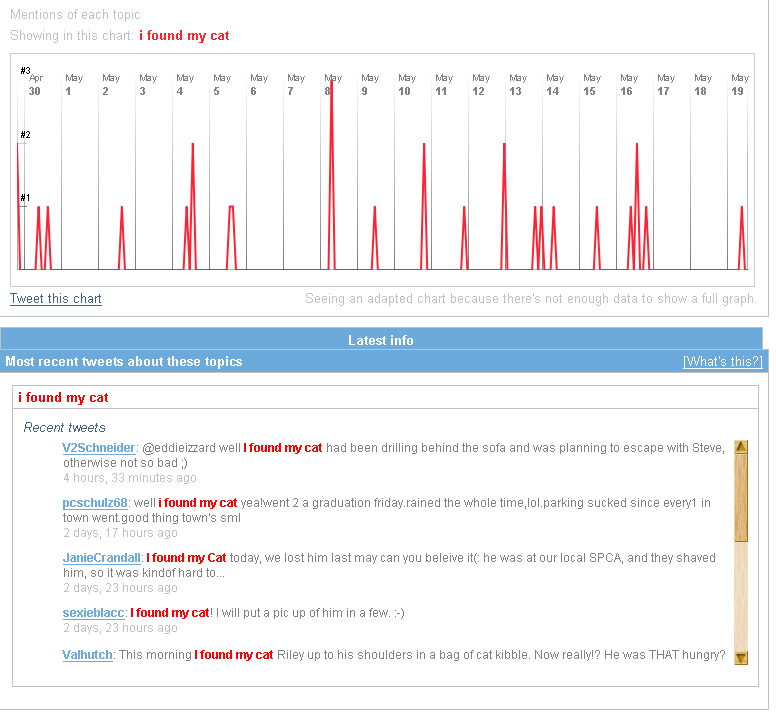
Below is a graph of mentions of "I found my dog" in Twitter 30 days before the May 17th Los Angeles 4.5 earthquake. A variation with t he same caveats as the cat found tweets above.
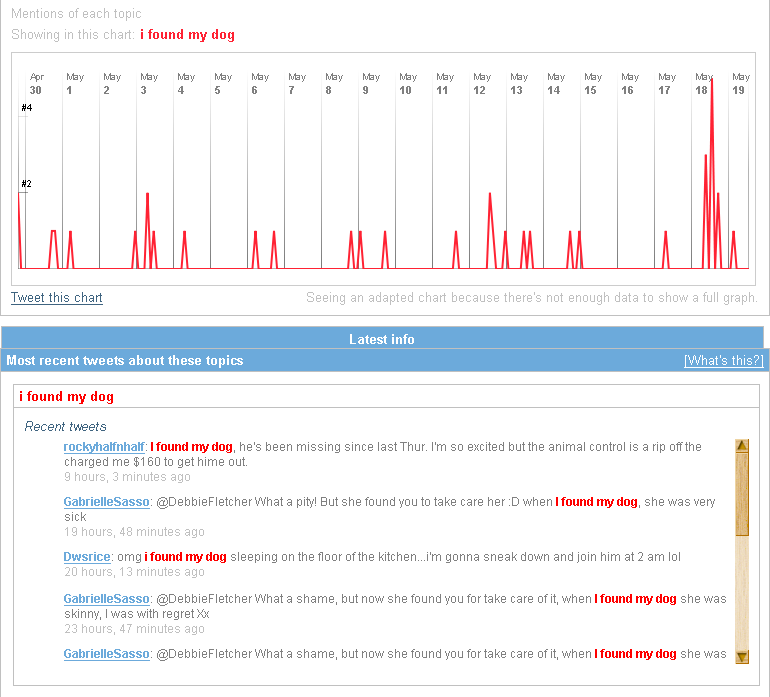
Below is a graph of mentions of "positive ions" in Twitter 30 days before the May 17th Los Angeles 4.5 earthquake. Studies have indicated that positive ions in the air before an earthquake may be the factor which triggers animals to flee the area before an earthquake. This is an attempt to quantify any human research or measurements of positive ions that might be tweeted. As expected the tweet level is very low.
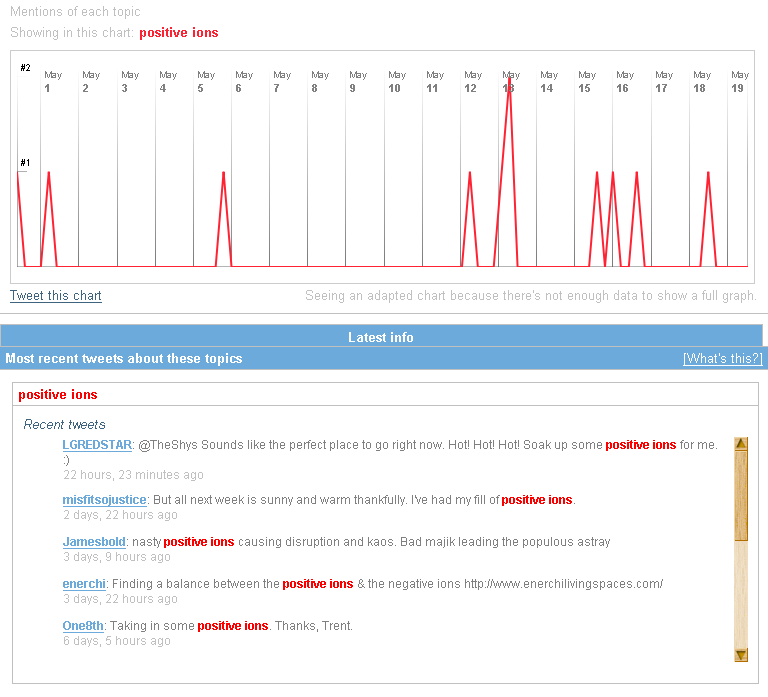
Below is a graph of mentions of "predicting an earthquake" in Twitter 30 days before the May 17th Los Angeles 4.5 earthquake. In addition to pet tweets the study went further to see if their was a significant increase in the tweets of people either predicting or hearing and Tweeting about other people who were "predicting an earthquake" before the earthquake happened.
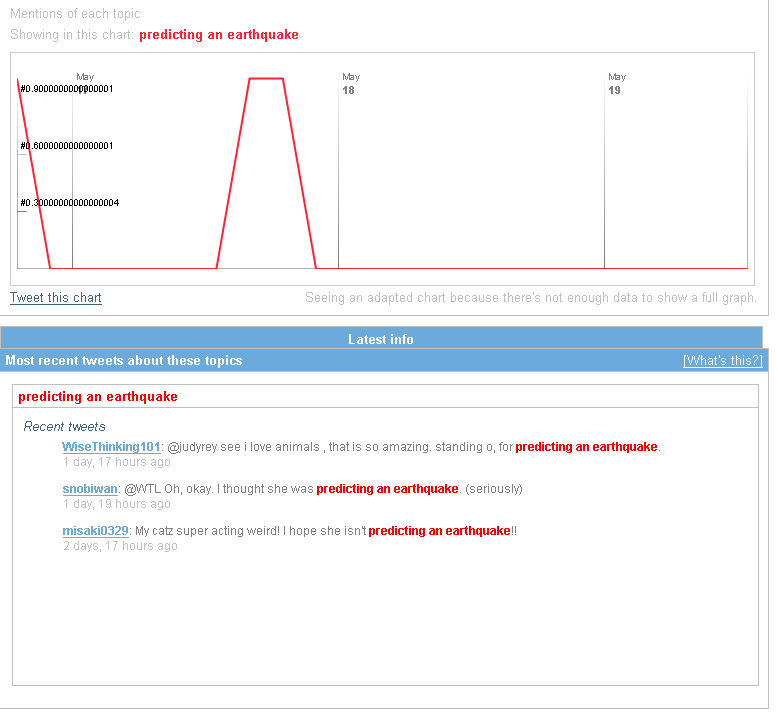
Below is a graph of mentions of "prediction earthquake" in Twitter 30 days before the May 17th Los Angeles 4.5 earthquake. A variation of the search terms indicating possible earthquakes predictions before the earthquake
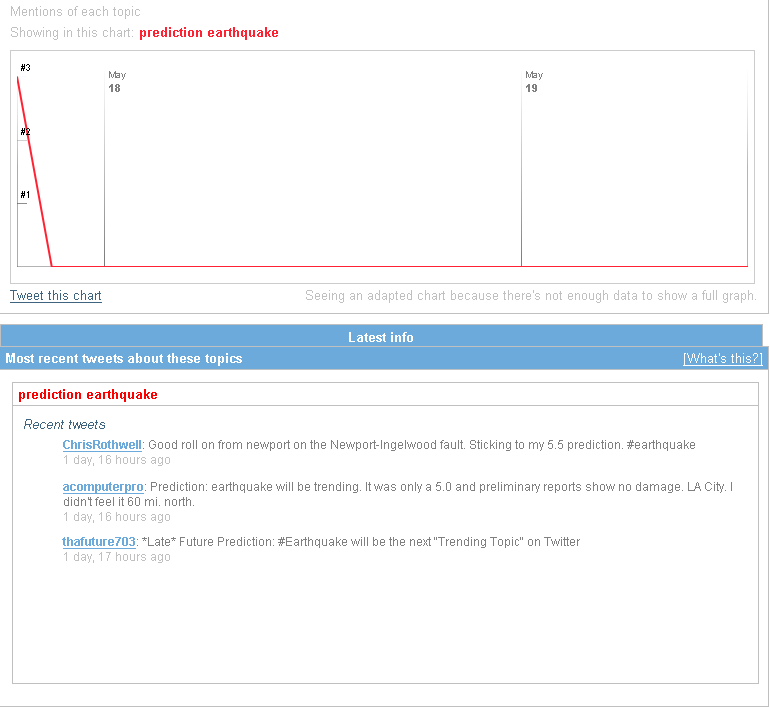
Below is a graph of mentions of "will be earthquake" in Twitter 30 days before the May 17th Los Angeles 4.5 earthquake. A variation of the search terms indicating possible earthquakes predictions before the earthquake.
